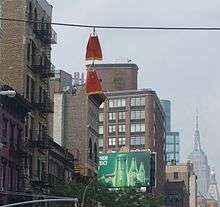Shoe tossing
_2.jpg)
Shoe tossing, the act of using shoes as projectiles or improvised weapons, is a constituent of a number of folk sports and practices. Today, it is commonly the act of throwing a pair of shoes onto telephone wires, powerlines, or other raised wires. A related practice is shoe tossing onto trees or fences.
Dangling shoes
Shoe dangling, or shoe flinging, is the practice of throwing shoes whose shoelaces have been tied together so that they hang from overhead wires such as power lines or telephone cables. Once the shoes are tied together, the pair is then thrown at the wires as a sort of bolas. The practice, despite its widespread use throughout the United States has been one of curiosity over the years as a number of possible explanations for the act have cropped up without any general consensus on its origins. Shoe flinging has also been reported in many other countries.
Shoe flinging occurs throughout the United States and Canada, in rural as well as in urban areas. Usually, the shoes flung at the wires are sneakers; elsewhere, especially in rural areas, many different varieties of shoes, including leather shoes and boots, also are thrown. There are many cultural variations as well, with differences between socio-economic areas and even age groups.
A number of criminal explanations have been proposed as to why this is done. The foremost is bullying in which a bully steals a pair of shoes and puts them in a place where they are unlikely to be retrieved. Or sometimes it is done as a practical joke played on drunkards.[1] A newsletter from the mayor of Los Angeles, California cites fears of many Los Angeles residents that "these shoes indicate sites at which drugs are sold or worse yet, gang turf", and that city and utility employees had launched a program to remove the shoes.[2]
Other less criminal explanations have been ventured for the practice. In some cultures, shoes are flung to commemorate the end of a school year, or a forthcoming marriage as part of a rite of passage. It has been suggested that the custom may have originated with members of the military, who are said to have thrown military boots, often painted orange or some other conspicuous color, at overhead wires as a part of a rite of passage upon completing basic training or on leaving the service.[1] In the 1997 film, Wag the Dog, shoe tossing features as an allegedly spontaneous cultural manifestation of tribute to Sgt. William Schumann, played by Woody Harrelson, who has purportedly been “shot down behind enemy lines” in Albania.
Others simply say that shoe flinging is a way to get rid of shoes that are no longer wanted, are uncomfortable, or do not fit.[3] It may also be another manifestation of the human instinct to leave their mark on, and decorate, their surroundings.[1]
In some neighborhoods, shoes tied together and hanging from power lines or tree branches signify that someone has died. The shoes belong to the dead person. The reason they are hanging, legend has it, is that when the dead person's spirit returns, it will walk that high above the ground, that much closer to heaven.[3] Another superstition holds that the tossing of shoes over the power lines outside of a house is a way to keep the property safe from ghosts. Yet another legend suggests that shoes hanging from telephone wires signal someone leaving the neighborhood onto bigger and better things.[4][5]
Shoe tree

A shoe tree, not to be confused with the shoe-preservation device of the same name, is a tree (or, occasionally, a powerline pole or other wooden object) that has been festooned with old shoes.[7] Shoe trees are generally located alongside a major local thoroughfare, and may have a theme (such as high-heeled shoes). There are currently at least seventy-six such shoe trees in the United States,[8] and an undetermined number elsewhere.
Competitive boot throwing

Boot throwing, or welly wanging, has been a competitive sport in New Zealand and Britain for many years, although not one that is taken very seriously. Wellington boots are the heavy rubber boots worn by most farm workers and many other outdoor workers. A competition to see who can throw a boot, or "welly", the furthest is a feature of many Agricultural Field Days in the rural communities. The town of Taihape in the central North Island is particularly identified with this sport; they claim to be the Gum Boot Throwing Capital of New Zealand. They hold an annual competition in the main street and award a Golden Gumboot as the trophy; see Wellie wanging.
Since 2003 the sport has been practiced competitively in Eastern Europe. The 2004 World Championship Competition was won by Germany who is hosting the 2005 Competition at Döbeln. Teams were also expected from Australia and Russia. Boot throwing has been a popular sport in Finland since 1976 when the first Finnish Championships of boot throwing has been organized.
The Scottish Championships were held in Oban in July 2009 where Shoe-Throwing pioneers RD Miller & David Gaffney created an impromptu event on the waterfront. This inspired such Shoe-Throwing legends as Phil Reid (who always favoured the lighter trainer)to pick up the baton - or the sneaker in this case - and take it to a wider audience. A more amateur watered-down version is still evident today in certain parts of Oban in July.
Insult
In many Arab cultures, it is considered an extreme insult to throw a shoe at someone. It is also considered rude even to display the sole of one's foot to someone. In 2008, Iraqi cameraman Muntadar al-Zaidi threw two shoes at United States President George W. Bush while the president was visiting Baghdad, and was arrested and incarcerated. President Bush ducked and was not struck by the shoes.[9] Shoe throwing as an insult is not just limited to the Muslim world, as there are also other notable incidents that have occurred involving other celebrities and world leaders. Some of these have involved Steve McCarthy, David Beckham, Harry Styles, Lily Allen, Hillary Clinton and Chinese Premier Wen Jiabao.[10]
Flipper tossing

"Flippering" has occurred in the Stoke Croft area of Bristol; a pair of flippers can be seen on Jamaica Street in Bristol. Flippers have also been seen over a wire in the East Village section of New York City (pictured).
See also
References
- 1 2 3 Adams Cecil (August 2, 1996). Why do you see pairs of shoes hanging by the laces from power lines? The Straight Dope.
- ↑ TeamWork LA (c. 2003). "East Los Angeles NSC Combats Problem of Overhead Shoes on Wires" (PDF). Archived from the original (PDF) on 2003-10-07. Retrieved 2007-06-15.
- 1 2 Wordscribe41. "Shoefiti: Unique Urban Street Art". Hubpages.
- ↑ Whitley, Peggy, Becky Bradley, Bettye Sutton, and Sue Goodwin. "1990-1999." American Cultural History. Lone Star College-Kingwood Library. Last modified February 2011. http://wwwappskc.lonestar.edu/ popculture/decade90.html.
- ↑ Alarcão, Jorge de (1988). Roman Portugal. Volume I: Introduction (p. 93). Warminster: Aris and Phillips
- ↑ The Shoe Tree in Frisbee Playground, Morley Field, San Diego fell down (allegedly on January 7, 2008, confirmed the following day), caused by a long period of rain.
- ↑ Shoe Trees. Roadside America.
- ↑ Roadside America. Search results for "shoe tree."
- ↑ Asser, Martin (December 15, 2008). "Bush shoe-ing worst Arab insult". BBC News. Retrieved July 22, 2012.
- ↑ "Top 5 famous shoe throwing incidents". Metro.
External links
- Bootthrowers' House
- Close-Up: New York's hanging sneakers – BBC News report looking at the phenomenon
